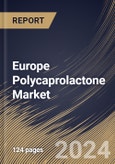PCL is a versatile and biodegradable polyester that has gained significant traction in many industries due to its unique properties and variety of applications. With its ability to be easily processed, biocompatibility, and degradation characteristics, PCL has become a preferred choice for manufacturers seeking sustainable and innovative solutions.
PCL is extensively used for various applications in the biomedical field. For example, PCL scaffolds are templates to support cell growth and tissue regeneration in bone, cartilage, and other tissue engineering applications. In addition, PCL is used to encapsulate and deliver drugs in a controlled manner, allowing for sustained release over time and targeted delivery to specific tissues or cells. PCL implants are used in orthopedic and reconstructive surgeries for bone fixation, bone void filling, and tissue augmentation due to their biocompatibility and biodegradability. Also, PCL-based wound dressings provide a protective barrier, promote wound healing, and facilitate tissue regeneration in chronic and acute wounds.
The growth of the cosmetics industry in Poland may stimulate innovation in product development. Companies may explore the use of polycaprolactone in novel cosmetic formulations. As per the quarterly report by the Polish Investment and Trade Agency focused on the cosmetics sector, the Polish cosmetics industry achieved a significant value close to €4 billion in 2020. Positioned as the fifth-largest cosmetics industry within the European Union, the cosmetics sector’s exports contributed to approximately 1.6% of the total goods exported by Poland in 2021. Hence, the expansion of the region’s cosmetics industry and 3D printing sector is propelling the market’s growth.
The Germany market dominated the Europe Polycaprolactone Market by Country in 2022, and would continue to be a dominant market till 2030; thereby, achieving a market value of $111.7 Million by 2030. The UK market is exhibiting a CAGR of 10% during (2023 - 2030). Additionally, The France market would experience a CAGR of 11.8% during (2023 - 2030).
Based on Production Method, the market is segmented into Ring Opening Polymerization, and Polycondesation of Carboxylic Acid. Based on Form, the market is segmented into Pellets, Nanosphere, and Microsphere. Based on Application, the market is segmented into Coating & Thermoplastic Polyurethane (TPU), Healthcare, and Others. Based on countries, the market is segmented into Germany, UK, France, Russia, Spain, Italy, and Rest of Europe.
List of Key Companies Profiled
- Corbion N.V.
- Otto Chemie Pvt. Ltd.
- BASF SE
- Perstorp Holding AB (PETRONAS Chemicals Group Berhad)
- Daicel Corporation
- Haihang Industry Co.,Ltd. (Haihang Group)
- Merck KGaA
- Polysciences, Inc.
- Shenzhen Esun Industrial Co., Ltd.
- Shenzhen Polymtek Biomaterial Co., Ltd.
Market Report Segmentation
By Production Method (Volume, Thousand Tonnes, USD Billion, 2019-2030)- Ring Opening Polymerization
- Polycondesation of Carboxylic Acid
- Pellets
- Nanosphere
- Microsphere
- Coating & Thermoplastic Polyurethane (TPU)
- Healthcare
- Others
- Germany
- UK
- France
- Russia
- Spain
- Italy
- Rest of Europe
Table of Contents
Companies Mentioned
- Corbion N.V.
- Otto Chemie Pvt. Ltd.
- BASF SE
- Perstorp Holding AB (PETRONAS Chemicals Group Berhad)
- Daicel Corporation
- Haihang Industry Co.,Ltd. (Haihang Group)
- Merck KGaA
- Polysciences, Inc.
- Shenzhen Esun Industrial Co., Ltd.
- Shenzhen Polymtek Biomaterial Co., Ltd.








